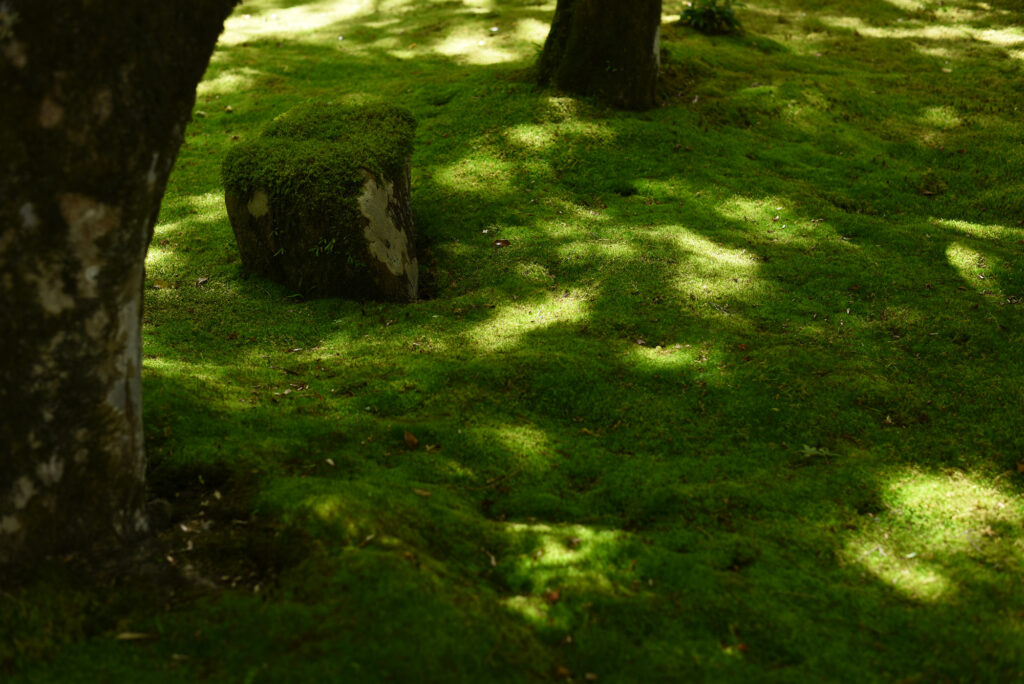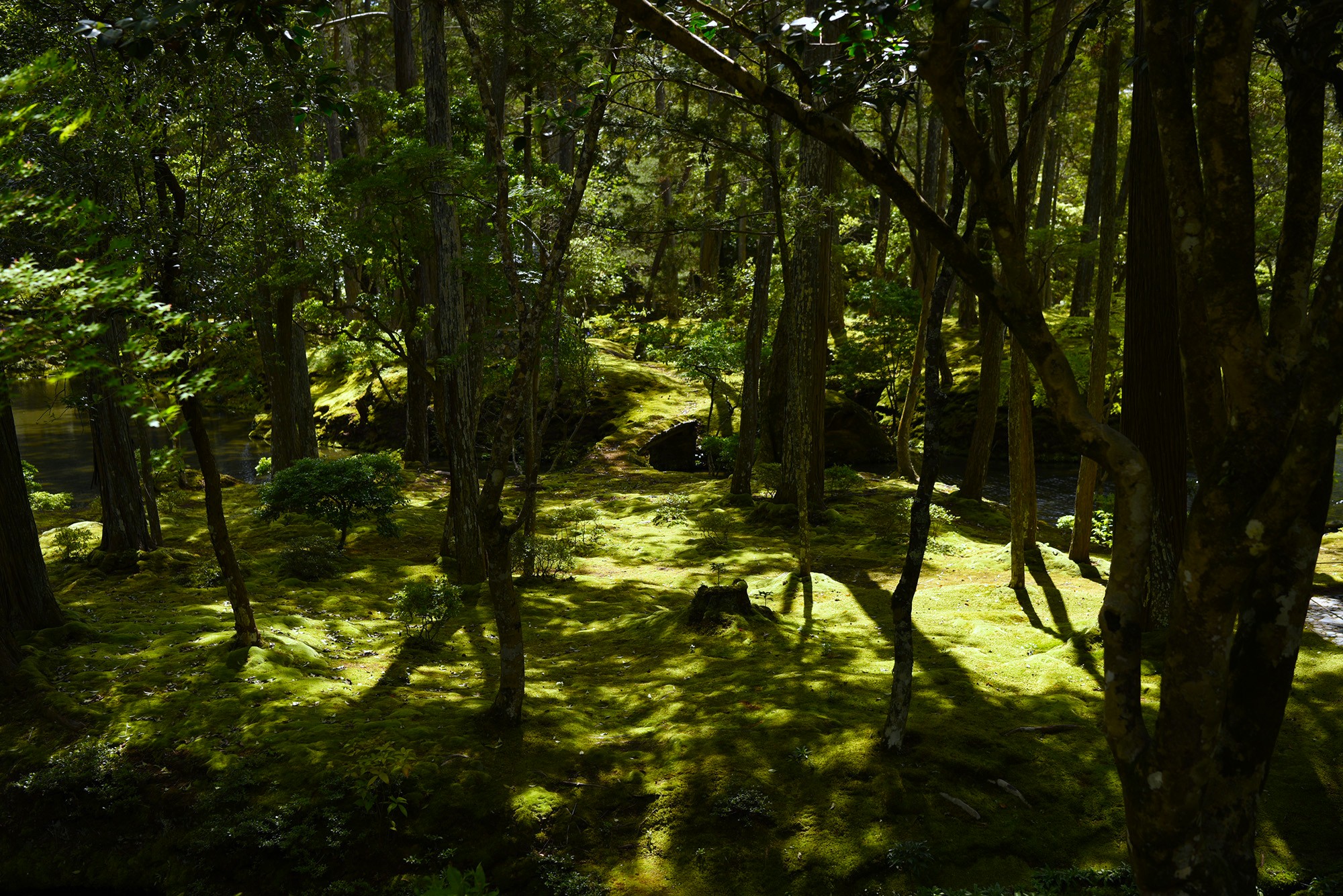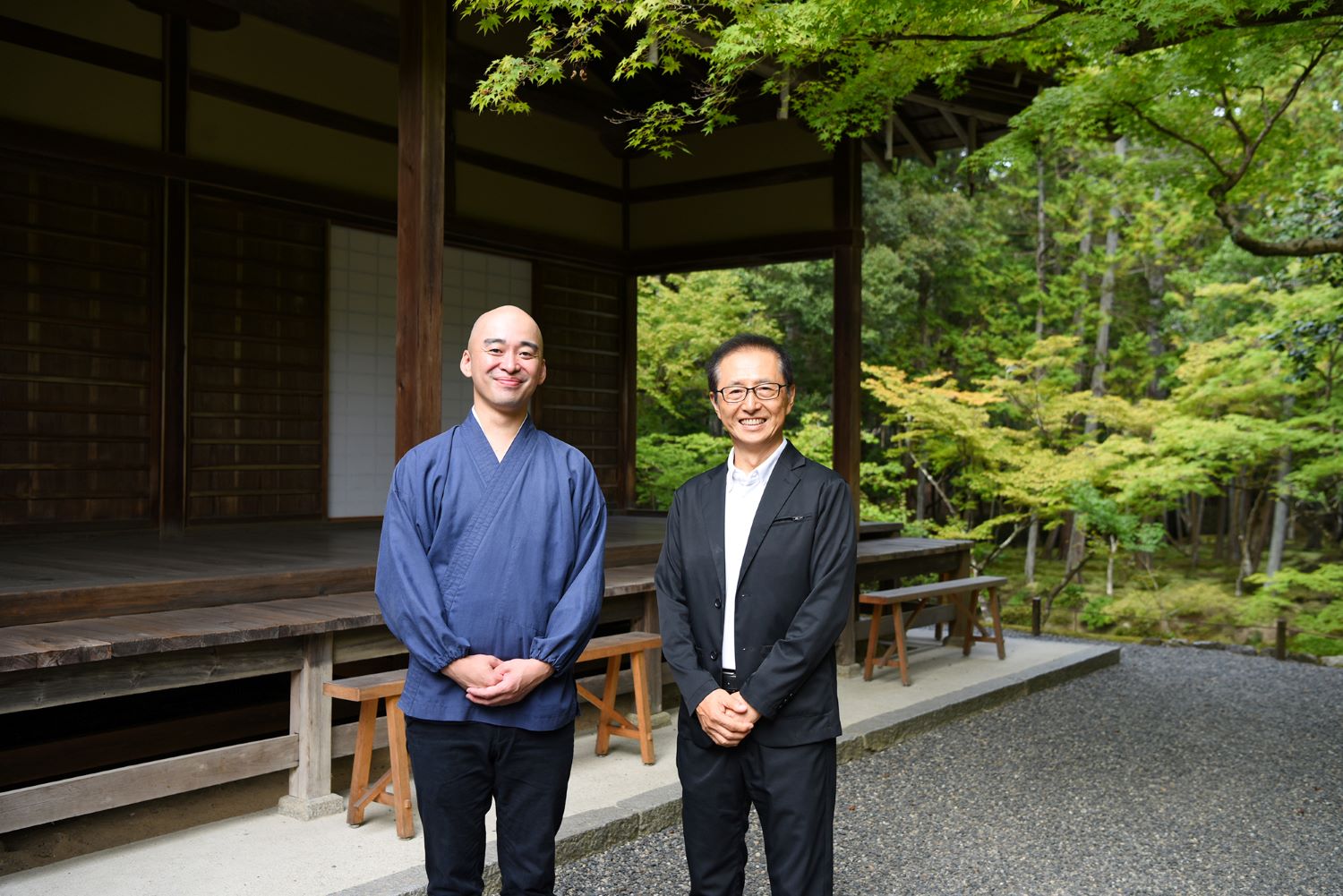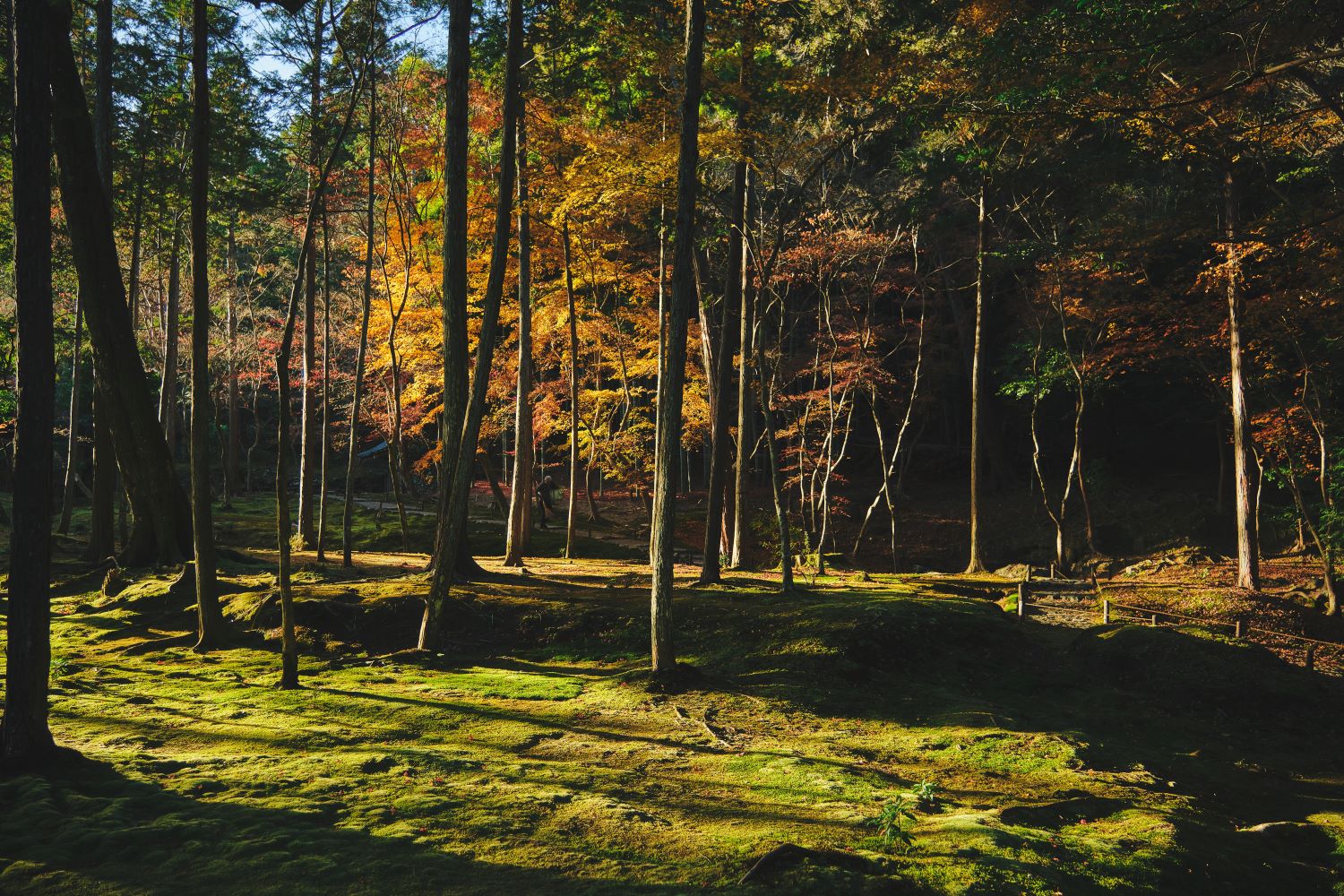2025.9.20
体露金風 西芳寺第十七景
ピーター・J・マクミラン
(翻訳家・詩人)
翻訳者であり詩人でもあるピーター・マクミラン氏が、西芳寺の魅力を綴る「体露金風 西芳寺」シリーズ。日本文化への造詣が深いピーター氏の感性と深い洞察が誘う、心の旅。ぜひ原文の美しい響きも、ご堪能ください。
言葉にしきれない美しさ
夏の盛り、にわか雨が上がった頃、頭上では葉の隙間に陽光が輝き、お庭は、そこから差し込む無数のまばゆい光の筋に包まれています。光の筋がベルベット状の苔地を照らし、そのエメラルド色の表面には、ちいさな雨粒が輝いています。空気に満ちるのは、湿った土と陽光に照らされた葉の香り。木々の影は長く伸び、苔地や園路に涼を添えています。
まるでレース生地のような葉影はやわらかな輪郭を帯び、頭上で枝がそよ風に揺られるたび、絶えず形を変えてゆきます。光と影が織りなす濃淡のなか、緑色のキルト生地のような苔地は光ったり陰ったりと点滅し、まるで苔そのものが輝きを放っているかのよう。池はキャンバスのように波紋と揺らぎを映し出し、そして空と光のまばゆい反射が浮かんでいます。お庭には、夏の魔法と神聖さと強烈さ、そして遠い昔の静寂が共存していました。

この真夏の西芳寺の濃密さを、この強烈さを、絶えず変わりゆく多様性に富んだ美をとらえたい。何度訪れても、どれだけの時間をお庭で過ごしても、私はこのお庭の美しさを言葉で表すことができずにいます。そういえばスコットランドの作家であるアリ・スミスは、小説『夏』でこんな言葉を残していました。
So, we mourn it while we’re in it. Look at me walking down a road in summer thinking about the transience of summer. Even while I’m right at the heart of it I just can’t get to the heart of it.
だから、私たちはその中にいながらも、その喪失を嘆く。私は夏の道を歩きながら、夏の儚さについて考えている。その真っ只中にいながらも、その神髄に辿り着けずにいるのだ。
私もどれほど挑戦しようとも、西芳寺の神髄をとらえきれずにいます。例えば、今日のお庭に差し込んでいた光は、次のような言葉で表現できるかもしれません。
灼熱、輝かしい、明るい、光り輝く、まばゆい、発光する、きらめく、黄金の、銀の、琥珀色の、玉虫色の、揺らめく、きらきらと光る、閃き、輝き、影、ほのかな光
確かに、これらの言葉は今日私が見た景色を表しているでしょう。ですが、表しきれていないとも言えます。

物書きとして、私はいつも言葉の限界に直面しています。自然の美しさを言葉でとらえようとしても、決してとらえきれません。それはまるで、アメリカの詩人、エミリー・ディキンソンの詩のようです。
“To see the Summer Sky”
To see the Summer Sky
Is Poetry, though never in a Book it lie—
True Poems flee—
『夏の空を見ること』
夏の空を見ること
それは詩
しかし、本の中にとどまることはない
真の詩は、飛んで逃げていくから
ディキンソンは、真の詩は本の中にはないと、経験と自然のなかにこそ存在するのだと、遊び心を交えて示しています。この詩が意味していることは、詩の本質は「書かれている言葉」ではなく、「自然界の美と不思議」を体感する中にあるということ。紙の上では、表現しきれないのです。皮肉なことに、ディキンソンは、自然の美をとらえようと試みるすべての作家が直面するジレンマを、みごとに美しい詩へと変えています。
西芳寺のお庭は、訪れるたびにその表情を変えます。とらえどころがなく、儚く、どれほど努力しても、決して完全にとらえることはできません。だからこそ、私は西芳寺を見つめながらも、言葉で表そうとしながらも、いつもやるせない想いを抱えているのです。
I Can’t Get to the Heart of It
It is the height of summer after a rain shower and the garden is covered in a dappled canopy, bathed in shafts of golden sunlight shining through the leaves in countless beams. The beams strike the velvet moss making the tiny dewdrops shimmer on its emerald surface. The air is filled with the scent of damp earth and sunlit leaves. The shadows of tree trunks stretch long and cool on the moss and on the path; other shadows are like lace, their edges soft and constantly shifting as the lightest breeze stirs the branches overhead. In the full and half-lights of shadow and sun, it is as if the moss is glowing from within, a luminous green quilt with flickering patterns of light and shade. The pond is a canvas of ripples and movement and dazzling reflections of the sky and light. The garden is filled with both the magic, sacred, intensity of summer movement and the stillness of ancient times.
I am trying to capture this density, this intensity, the everchanging endless variety of the beauty of Saihoji of a hot summer day. No matter how many times, nor how long I stay, I can never truly capture the beauty of the garden in words. I recall the lines of Scottish novelist Ali Smith in her novel Summer:
So, we mourn it while we’re in it. Look at me walking down a road in summer thinking about the transience of summer. Even while I’m right at the heart of it I just can’t get to the heart of it.
No matter how I also try, I can’t capture the heart of Saihoji. For example, perhaps some of these words will capture the light of the garden today:
Blazing, brilliant, bright, radiant, dazzling, glowing, gleaming, golden, silver, amber, iridescent, flickering, shimmering, glints, gleams, shadows, shimmers.
Yes, they do, but no they don’t, too.
As a writer I always face the limits of language and the fact that the beauty of nature refuses to be trapped in words. It is like the poem by Emily Dickinson.
“To see the Summer Sky”
To see the Summer Sky
Is Poetry, though never in a Book it lie—
True Poems flee—
Dickinson playfully suggests that real poetry is not found in books—it exists instead in experience and nature. The poem suggests that the essence of poetry lies not in written language, but in experiencing the beauty and mystery of the natural world—something that can't be fully captured or trapped on a page. Ironically, she transforms the dilemma that all writers face in trying to capture the beauty of the natural world into a truly beautiful poem.
The garden of Saihoji is different on each occasion that I go. It is also elusive and fleeting and no matter how hard I try, I can never capture it fully. That is why, while I am always observing Saihoji, always trying to capture it, I am also always mourning it.
Peter MacMillan ピーター・J・マクミラン
翻訳家・詩人。株式会社 月の舟(制作・翻訳会社) 代表取締役。
2008年に英訳『百人一首』を出版し、日米で翻訳賞を受賞。2016年9月には英訳『The Tales of Ise』(伊勢物語)、2017年には英訳『One Hundred Poets One Poem Each(新訳)』の2冊がPenguin Booksより出版される。近著に『日本の古典を英語で読む』『英語で味わう万葉集』など著書多数。2019年より朝日新聞にて「星の林に」、2022年より京都新聞にて「不思議の国の和歌ワンダーランド 英語で読む百人一首」を連載。

翻訳:福田安奈






